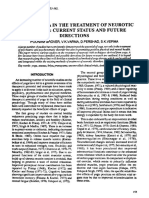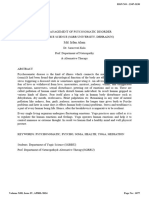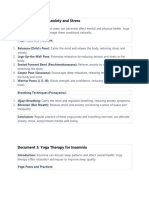Yoga Therapy
Yoga Therapy
Uploaded by
vvk639228Copyright:
Available Formats
Yoga Therapy
Yoga Therapy
Uploaded by
vvk639228Copyright
Available Formats
Share this document
Did you find this document useful?
Is this content inappropriate?
Copyright:
Available Formats
Yoga Therapy
Yoga Therapy
Uploaded by
vvk639228Copyright:
Available Formats
Yoga Therapy The Yoga Therapy or Yoga Chikitsa refers to the treatment of diseases by means of Yogic practices which
may be physical or mental or both. It is a specialized form of Yogic culture. This mode of treatment has been practiced in India from very ancient times. Many references of Yoga have been made in the Upanisads. In the 1st century BC Maharshi Patanajali gave a systematic account of the traditional Yogic techniques. The term Yoga is derived from the Sanskrit root to join. It signifies the union between the individual soul or Jivatman and the universal soul or Parmataman. It aims at obtaining relief from pain & suffering. Loss of a balanced state of mind is really the origin of many diseases. We overeat, overdrink, overtire ourselves. We go beyond the law of nature & finally develop some health problems. In fact, the science of yoga is not the therapy. It is a system of education on how to live healthy, not only physically but also mentally & spiritually. It is not proved that standing on your head would stop graying your hair. In fact, if you wish to stop the disease process, you have to learn to live in a healthy way. Basically human evolution takes place on 3 different planes, namely physical, mental & spiritual. We can attain perfect health by maintaining harmony & achieving optimum functioning on all 3 levels. Here complete self control is necessary. To understand therapy, the cause, course & manifestation of disease is to be known. We would not understand the concept of disease unless we know the concept of health. The Sanskrit term for health is Swaasthya and for a healthy person is Swastha. The word Swastha means the one who is established in ones own self. Surprisingly, a similar expression is used in the Yoga Sutra I:3 (please insert Sanskrit sutra here) i.e. the seer is established on his own. So the highest limit of health & the ultimate goal of Yoga seems to be identical. The mind has 5 stages which are know as Citta Bhumis. They are Kshipta, Mudha, Vikshipta, Ekagra & Niruddha. Fluctuations or Vrittis are also classified into 5 kinds. Pramada, Viparyaya, Vikalpa, Nidra & Smurti. These 5 Citta Bhumis & Citta Vrittis may disturb the Sadhaka or help him to develop maturity of intelligence & attain Vairagya (emancipation). There are a number of Antaraayas (obstacles) that arise in the journey. 9 Antarayas are Vyadhi, Styana, Samsaya, Pramada, Alasya, Avirati, Alabdha Bhumikatva, Anavasthitativa, Bhrantidarsana. There are 4 other Kleshas Dukha, Daurmanasya, Angamejayathwa, Shwasaprashwasaha. These 4 come as a result of other Antarayas. The ultimate course of pain & misery is Avidya i.e. ignorance of reality. It is the main cause of all physical diseases. By developing discriminate knowledge between Purusha & Prakriti, Avidya can be destroyed. Thus, the future misery or pain can be avoided. Yoga is
really the therapy. Lack of true knowledge is the source of all sorrows & pain whether it is dormant, attenuated, interrupted or fully active. Patanjali said that Avidya is the breeding ground of all affliction. Here is an example of Avidya. Iron & coal are two different entities. But when iron is heated, it becomes red hot & looks like coal. Similarly, though the body & the eternal self are distinct entities, lack of knowledge makes one believe that they are one. Patanjali is saying that Yoga is a preventive healing art, science & philosophy. One can build up health of body & mind. One can also construct a defensive strength. Science of medicine has 4 divisions: (1) disease (2) cause of disease (3) relief or diagnosis (4) remedy of treatment So also, Yoga therapy has also 4 divisions (1) Heya cause Avidya (2) Heyahetu Reason, Bondage Samyoga of seer with seen (3) Hana Release, Relief (4) Hanupaya Remedies Vivek khyati, Astnaga Yoga (1) Heya In Yoga Sutra of Patanjali II.16 (Insert Sutra here) i.e. the pain which is yet to come is to be avoided The pain which is past has been exhausted through experience. It cannot be avoided. Suffering of present moment is also not avoidable. It is only the pain that is yet to come that is to be avoided. Consciousness is identified with its outer vehicle the intelligence, ego, mind & other objects. Through discriminative knowledge, the Yogi liberates himself from this association & avoids pain yet to come. (2) HeyaHetu II.17 (Insert Sutra here). The cause of pain I is the association of the seer with the seen. The remedy lies in their dissociation. A knowable object is revealed only by consciousness itself. Knowable objects exist to serve the Purusa. However, this eternal relationship between the Purusa & the objects, blinds the Purusa as it were & this causes pain & is the cause of avoidable misery. Vyasa explains the Sutra in the following way (3) Hana II 25 (Insert Sutra here) If ignorance ceases, there is absence of conjunction. This is the isolation of the seer. Wish absence of ignorance, there is the absence of Buddhi (intelligence) and Purusa (consciousness) coming together. There is complete stoppage of bondage. Thereafter Purusa is not mixed with gunas. With the elimination of ignorance, the Purusa is established in its own nature.
(4) Hanapaya Remedies II 26 (Insert Sutra here) The means to attaining isolation is undisturbed discriminative knowledge. Vivekakhyati is the highest discriminative knowledge. It is the capacity to see the difference between Buddhi (intelligence) and Purusa (consciousness). It helps to get a direct and immediate contact with the innermost spiritual consciousness. When the mind becomes pure, it becomes desireless, when it realizes the matter, discriminative enlightenments. When this is continuous, it leads to liberation (kaivalya). The afflictions have been burnt, Rajas & Tamas have been neutralized to gain Vivekakyati. Yoga may be of help even for worldly people to overcome unsteadiness. The kleshas, in the nature of impurities have to be destroyed through discriminative knowledge. Practice of the 8-fold path opens a new state of consciousness.
You might also like
- ContrologyDocument11 pagesContrologyLameuneNo ratings yet
- What Are Anxiety Disorders?: CausesDocument50 pagesWhat Are Anxiety Disorders?: CausesRaviSankarNo ratings yet
- Yogatherapy by GitananadDocument15 pagesYogatherapy by GitananadIngrid Vanherpe0% (1)
- Gita Presentation 3.0Document26 pagesGita Presentation 3.0Viji VenkatramanNo ratings yet
- Core Values YogaDocument49 pagesCore Values Yogapassion26No ratings yet
- Plimentary and Alternative TherapiesDocument17 pagesPlimentary and Alternative TherapiesVeena DalmeidaNo ratings yet
- Yoga in The Treatment of Neurotic Disorders PDFDocument10 pagesYoga in The Treatment of Neurotic Disorders PDFDejana AnaNo ratings yet
- Yoga As A Method of Personal Development by Danica LepojevicDocument9 pagesYoga As A Method of Personal Development by Danica LepojevicDanica Ivanovska LepojevicNo ratings yet
- Ayurvedic Management of SciaticaDocument7 pagesAyurvedic Management of SciaticaSummit GautamNo ratings yet
- The Influence of Yoga Therapy On AnxietyDocument9 pagesThe Influence of Yoga Therapy On AnxietypronitNo ratings yet
- Therapeutic Benefits of Yogas PranayamasDocument12 pagesTherapeutic Benefits of Yogas Pranayamaspsi.cynthiavianaNo ratings yet
- Yoga and Menopausal TransitionDocument3 pagesYoga and Menopausal TransitionTejaNo ratings yet
- Ayurvedic PDFDocument4 pagesAyurvedic PDFDrMohamed Rifas100% (1)
- Yoga and TherapyDocument5 pagesYoga and TherapymargaritassNo ratings yet
- Yoga For Cancer: DR R Nagarathna MD, FRCP (Edin) Medical Director Swami Vivekananda Yoga Anusndhana SamsthanaDocument34 pagesYoga For Cancer: DR R Nagarathna MD, FRCP (Edin) Medical Director Swami Vivekananda Yoga Anusndhana SamsthanaAnonymous DgAZYkmQfNo ratings yet
- Yoga For Anxiety and HypertensionDocument2 pagesYoga For Anxiety and HypertensionnawazdakhveNo ratings yet
- AV Therapists PDFDocument22 pagesAV Therapists PDFGurpreet Kaur100% (1)
- Role of Resilience in Clinical Pain MGMTDocument10 pagesRole of Resilience in Clinical Pain MGMTGarrett ZajicekNo ratings yet
- Smith, K. B. & Pukall, C. F. (2009) - An Evidence-Based Review of Yoga As A Complementary Intervention For Patients With CancerDocument12 pagesSmith, K. B. & Pukall, C. F. (2009) - An Evidence-Based Review of Yoga As A Complementary Intervention For Patients With CancerDerly ObtialNo ratings yet
- Yoga TherapyDocument95 pagesYoga Therapysivaprasth_vNo ratings yet
- David Frawley - Wikipedia, ..Document7 pagesDavid Frawley - Wikipedia, ..LakshmiPriyaNo ratings yet
- Yogic Management of Psycosomatic Disorder by Md. Irfan AlamDocument20 pagesYogic Management of Psycosomatic Disorder by Md. Irfan AlamHealing MindNo ratings yet
- Mindfulness Practitioner Course: Level I, Ii, Iii & Master The Attitudinal Foundations of MindfulnessDocument5 pagesMindfulness Practitioner Course: Level I, Ii, Iii & Master The Attitudinal Foundations of MindfulnessEduardo Mello LucenaNo ratings yet
- Dhyana: Tatra Pratyaya Ektanata Dhyanam - P.Y.S. 3/2Document4 pagesDhyana: Tatra Pratyaya Ektanata Dhyanam - P.Y.S. 3/2Ccywi CcywiNo ratings yet
- Yoga Therapy For Anxiety and StressDocument2 pagesYoga Therapy For Anxiety and StressYash Hsay100% (1)
- Jnana Yoga Presentation ScriptDocument4 pagesJnana Yoga Presentation ScriptTarak KoraNo ratings yet
- Bhagvad Gita's Concept of HealthDocument5 pagesBhagvad Gita's Concept of Healtharyanpal2082006No ratings yet
- 5 Points of Yoga Wellness: 1. Proper Exercise (Asana)Document4 pages5 Points of Yoga Wellness: 1. Proper Exercise (Asana)tulikaNo ratings yet
- Psychoeducation Barcelona ModelDocument12 pagesPsychoeducation Barcelona ModelAnnPSWNo ratings yet
- Yoga & ObesityDocument194 pagesYoga & ObesitydrmadankumarbnysNo ratings yet
- UNIT 1.5 Methods of Teaching Yoga To An Individual, Small Group and Large GroupDocument1 pageUNIT 1.5 Methods of Teaching Yoga To An Individual, Small Group and Large GroupCcywi CcywiNo ratings yet
- OCD Yoga CureDocument3 pagesOCD Yoga CureAnubhav GargNo ratings yet
- Description of Anatomy and PhisiologyDocument16 pagesDescription of Anatomy and PhisiologyBalasubramanian Kanchipuram SundararamanNo ratings yet
- Ayurveda International Conference in Rishikesh 2008Document47 pagesAyurveda International Conference in Rishikesh 2008Punarnava AyurvedaNo ratings yet
- ACTIVE RECREATION FITNESS (Genyo)Document30 pagesACTIVE RECREATION FITNESS (Genyo)vj hernandez100% (1)
- Physical DependenceDocument7 pagesPhysical Dependencehasan jamiNo ratings yet
- Control The Life in Yoga WayDocument7 pagesControl The Life in Yoga Wayname100% (1)
- Dinacharya PDFDocument3 pagesDinacharya PDFKrishnaswamy JajimoggalaNo ratings yet
- Teaching Yoga For ScoliosisDocument6 pagesTeaching Yoga For ScoliosiskafkathebugNo ratings yet
- Kinesiology and Yoga Body Knowledge W PictureDocument8 pagesKinesiology and Yoga Body Knowledge W Pictureapi-198455138No ratings yet
- Mid Semester - Tutorial (Health Science-26.04.11)Document16 pagesMid Semester - Tutorial (Health Science-26.04.11)Rishikaphriya Rauichandran100% (1)
- Anxiety WorkbookDocument9 pagesAnxiety WorkbookSanya GoelNo ratings yet
- Consensus On Current Management of EndometriosisDocument17 pagesConsensus On Current Management of EndometriosisCristina BravoNo ratings yet
- Place of Nutrition in YogaDocument8 pagesPlace of Nutrition in YogaGreen RiverNo ratings yet
- Life Sciences (1) Ayurveda For Life, Health and Well-Being - Part 1 1Document23 pagesLife Sciences (1) Ayurveda For Life, Health and Well-Being - Part 1 1arokiaNo ratings yet
- Cusack2018 Misophonia Anxiety Sensitivity and Obsessive Compulsive SymptomsDocument22 pagesCusack2018 Misophonia Anxiety Sensitivity and Obsessive Compulsive Symptomszerocool123No ratings yet
- 2000 Glazier A Landmark in The History of AyurvedaDocument1 page2000 Glazier A Landmark in The History of Ayurvedanermal93No ratings yet
- Gestalt Peeling The Onion Csi Presentatin March 12 2011Document6 pagesGestalt Peeling The Onion Csi Presentatin March 12 2011Adriana Bogdanovska ToskicNo ratings yet
- Yoga Therapy For EpilepsyDocument7 pagesYoga Therapy For EpilepsyRekha SharmaNo ratings yet
- Diploma in Yoga & Naturopathy, 2017Document185 pagesDiploma in Yoga & Naturopathy, 2017hemraj.koiralaNo ratings yet
- YogaDocument4 pagesYogarockalecsNo ratings yet
- YogaDocument8 pagesYogaamrulloh qusyainyNo ratings yet
- Navchetana-Module-Book - 1 Eng 040722Document88 pagesNavchetana-Module-Book - 1 Eng 040722ankit.shrivastavaNo ratings yet
- Complete CBT OverviewDocument100 pagesComplete CBT Overviewzainabmanzoor8788No ratings yet
- Yoga For Women of Rreproductive AgeDocument100 pagesYoga For Women of Rreproductive AgeSheethalNo ratings yet
- The Art of Holistic Pain Management: A Practical HandbookFrom EverandThe Art of Holistic Pain Management: A Practical HandbookNo ratings yet



























































